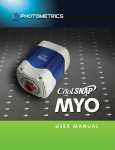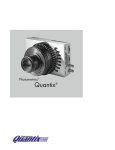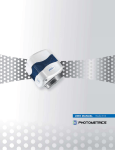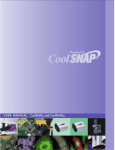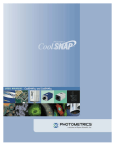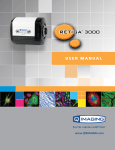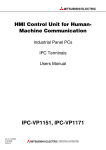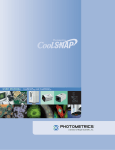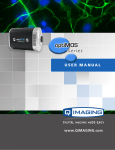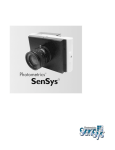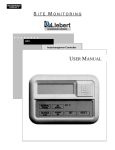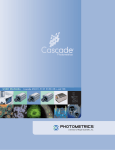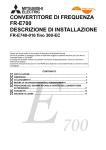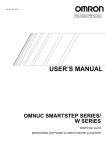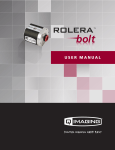Download CoolSNAP KINO User Manual
Transcript
USER MANUAL
© Copyright 2013
Photometrics
3440 East Britannia Drive
Tucson, Arizona 85706
Tel: +1 520.889.9933
Fax: +1 520.295.0299
All rights reserved. No part of this publication may be reproduced by any means without the written permission
of Photometrics.
57-557-002 Rev A0
Acrobat and Reader are registered trademarks of Adobe Systems Incorporated in the United States and/or other
countries.
CoolSNAP is a trademark and Photometrics and PVCAM are registered trademarks of Roper Scientific, Inc.
Intel Core is a trademark of Intel Corporation in the U.S. and/or other countries.
Windows is a registered trademark of Microsoft Corporation in the United States and/or other countries.
Other brand and product names are the trademarks or registered trademarks of their respective owners and
manufacturers.
The information in this publication is believed to be accurate as of the publication release date. However,
Photometrics does not assume any responsibility for any consequences including any damages resulting from the
use thereof. The information contained herein is subject to change without notice. Revision of this publication
may be issued to incorporate such change.
LIMITED WARRANTY
Photometrics (“Photometrics,” us,” “we,” “our”) makes the following limited warranties. These limited
warranties extend to the original purchaser (“You”, “you”) only and no other purchaser or transferee. We have
complete control over all warranties and may alter or terminate any or all warranties at any time we deem
necessary.
Basic Limited Two (2) Year Warranty
Photometrics warrants this product against substantial defects in materials and/or workmanship for a period of up
to two (2) years after shipment. During this period, Photometrics will repair the product or, at its sole option,
repair or replace any defective part without charge to you. You must deliver the entire product to the
Photometrics factory or, at our option, to a factory-authorized service center. You are responsible for the shipping
costs to return the product. International customers should contact their local Photometrics-authorized
representative/distributor for repair information and assistance, or visit our technical support page at
www.photometrics.com.
Limited One (1) Year Warranty on Refurbished or Discontinued Products
Photometrics warrants, with the exception of the CCD imaging device (which carries NO WARRANTIES EXPRESS
OR IMPLIED), this product against defects in materials or workmanship for a period of up to one (1) year after
shipment. During this period, Photometrics will repair or replace, at its sole option, any defective parts, without
charge to you. You must deliver the entire product to the Photometrics factory or, at our option, a factoryauthorized service center. You are responsible for the shipping costs to return the product to Photometrics.
International customers should contact their local Photometrics representative/distributor for repair information
and assistance or visit our technical support page at www.photometrics.com.
Normal Wear Item Disclaimer
Photometrics does not warrant certain items against defect due to normal wear and tear. These items include
internal and external shutters, cables, and connectors. These items carry no warranty, expressed or implied.
Sealed Chamber Integrity Limited 24-Month Warranty
Photometrics warrants the sealed chamber integrity of all our products for a period of twenty-four (24) months
after shipment. If, at anytime within twenty-four (24) months from the date of delivery, the detector should
experience a sealed chamber failure, all parts and labor needed to restore the chamber seal will be covered by us.
Open chamber products carry NO WARRANTY TO THE CCD IMAGING DEVICE, EXPRESSED OR IMPLIED.
Responsibility for shipping charges is as described above under our Basic Limited Two (2) Year Warranty.
Vacuum Integrity Limited 24-Month Warranty
Photometrics warrants the vacuum integrity of all our products for a period of up to twenty-four (24) months
from the date of shipment. We warrant that the detector head will maintain the factory-set operating
temperature without the requirement for customer pumping. Should the detector experience a Vacuum Integrity
failure at anytime within twenty-four (24) months from the date of delivery all parts and labor needed to restore
the vacuum integrity will be covered by us. Responsibility for shipping charges is as described above under our
Basic Limited Two (2) Year Warranty.
Software Limited Warranty
Photometrics warrants all of our manufactured software discs to be free from substantial defects in materials
and/or workmanship under normal use for a period of one (1) year from shipment. Photometrics does not
warrant that the function of the software will meet your requirements or that operation will be uninterrupted or
error free. You assume responsibility for selecting the software to achieve your intended results and for the use
and results obtained from the software. In addition, during the one (1) year limited warranty, the original
purchaser is entitled to receive free version upgrades. Version upgrades supplied free of charge will be in the form
of a download from the Internet. Those customers who do not have access to the Internet may obtain the version
upgrades on a CD-ROM from our factory for an incidental shipping and handling charge. See Item 12 in the
following section of this warranty ("Your Responsibility") for more information.
Owner’s Manual and Troubleshooting
You should read the owner’s manual thoroughly before operating this product. In the unlikely event that you
should encounter difficulty operating this product, the owner’s manual should be consulted before contacting the
Photometrics technical support staff or authorized service representative for assistance. If you have consulted the
owner’s manual and the problem still persists, please contact the Photometrics technical support staff or our
authorized service representative. See Item 12 in the following section of this warranty ("Your Responsibility")
for more information.
i
Your Responsibility
The above Limited Warranties are subject to the following terms and conditions:
1. You must retain your bill of sale (invoice) and present it upon request for service and repairs or provide
other proof of purchase satisfactory to Photometrics.
2. You must notify the Photometrics factory service center within thirty (30) days after you have taken
delivery of a product or part that you believe to be defective. With the exception of customers who claim
a “technical issue” with the operation of the product or part, all invoices must be paid in full in
accordance with the terms of sale. Failure to pay invoices when due may result in the interruption and/or
cancellation of your two (2) year limited warranty and/or any other warranty, expressed or implied.
3. All warranty service must be made by the Photometrics factory or, at our option, an authorized service
center.
4. Before products or parts can be returned for service you must contact the Photometrics factory and
receive a return authorization number (RMA). Products or parts returned for service without a return
authorization evidenced by an RMA will be sent back freight collect.
5. These warranties are effective only if purchased from the Photometrics factory or one of our authorized
manufacturer's representatives or distributors.
6. Unless specified in the original purchase agreement, Photometrics is not responsible for installation,
setup, or disassembly at the customer’s location.
7. Warranties extend only to defects in materials or workmanship as limited above and do not extend to
any product or part which has:
•
been lost or discarded by you;
•
been damaged as a result of misuse, improper installation, faulty or inadequate maintenance, or
failure to follow instructions furnished by us;
•
had serial numbers removed, altered, defaced, or rendered illegible;
•
been subjected to improper or unauthorized repair; or
•
been damaged due to fire, flood, radiation, or other “acts of God” or other contingencies beyond
the control of Photometrics.
8. After the warranty period has expired, you may contact the Photometrics factory or a Photometricsauthorized representative for repair information and/or extended warranty plans.
9. Physically damaged units or units that have been modified are not acceptable for repair in or out of
warranty and will be returned as received.
10. All warranties implied by state law or non-U.S. laws, including the implied warranties of merchantability and
fitness for a particular purpose, are expressly limited to the duration of the limited warranties set forth above.
With the exception of any warranties implied by state law or non-U.S. laws, as hereby limited, the forgoing
warranty is exclusive and in lieu of all other warranties, guarantees, agreements, and similar obligations of
manufacturer or seller with respect to the repair or replacement of any parts. In no event shall Photometrics’
liability exceed the cost of the repair or replacement of the defective product or part.
11. This limited warranty gives you specific legal rights and you may also have other rights that may vary
from state to state and from country to country. Some states and countries do not allow limitations on
how long an implied warranty lasts, when an action may be brought, or the exclusion or limitation of
incidental or consequential damages, so the above provisions may not apply to you.
12. When contacting us for technical support or service assistance, please refer to the Photometrics factory of
purchase, contact your authorized Photometrics representative or reseller, or visit our technical support
page at www.photometrics.com.
ii
CoolSNAP KINO User Manual
U. S. Government Restricted Rights
The software and documentation are provided with Restricted Rights. Use, duplication, or disclosure by the
Government is subject to restrictions as set forth in subparagraph (c)(1)(ii) of the Rights in Technical Data and
Computer Software clause at DFARS 252.227-7013 or subparagraphs (c)(1) and (2) of the Commercial Computer
Software-Restricted Rights at 48 CFR 52.227-19, as applicable. Contractor/manufacturer is Photometrics, 3440
East Britannia Drive, Tucson, AZ 85706.
This license is effective until terminated. It will terminate upon the conditions set forth above or if you fail to
comply with any term hereof. Upon termination, you agree that the software and accompanying materials, and
all copies thereof, will be destroyed. This agreement is governed by the laws of the State of Arizona. You
acknowledge that you have read this agreement, you understand it, you agree to be bound by its terms, and that
this is the complete and exclusive statement of the agreement between you and Photometrics regarding the
software.
iii
iv
CoolSNAP KINO User Manual
This page intentionally left blank.
v
Table of Contents
Chapter 1. Introduction
Description ..................................................................................................................... 1
System Components....................................................................................................... 1
About This Manual ......................................................................................................... 2
Precautions..................................................................................................................... 2
Environmental Requirements .......................................................................................... 3
Storage Requirements..................................................................................................... 3
Microscopes, Lenses, and Tripods ................................................................................... 3
Repairs ........................................................................................................................... 3
Cleaning ......................................................................................................................... 3
Photometrics Customer Service....................................................................................... 4
Chapter 2. System Installation
Introduction.................................................................................................................... 5
Software Compatibility Requirements ............................................................................. 5
Host Computer Requirements......................................................................................... 5
Multiple Cameras ........................................................................................................... 6
Software Installation ....................................................................................................... 6
Installing the PCI/USB 2.0 Card ...................................................................................... 6
Connecting Your CoolSNAP KINO Camera..................................................................... 7
Chapter 3. Operating Features
Dual-Mode Operation .................................................................................................... 9
Normal mode ........................................................................................................... 9
Alternate Normal mode.......................................................................................... 10
Antiblooming ......................................................................................................... 10
Triggered Operation ..................................................................................................... 10
Trigger-first mode .................................................................................................. 11
Strobe mode .......................................................................................................... 11
Bulb mode ............................................................................................................. 11
CoolSNAP KINO Application Examples ......................................................................... 12
Example 1 .............................................................................................................. 12
Example 2 .............................................................................................................. 12
Example 3 .............................................................................................................. 12
Example 4 .............................................................................................................. 12
Chapter 4. Troubleshooting
New Hardware Found Dialog Box Does Not Appear ...................................................... 13
Images Not Displayed................................................................................................... 13
Bright Spots in Image / Increased Background Noise ........................................................ 14
Camera Running Too Warm ......................................................................................... 14
PVCAM Error Message Appears ................................................................................... 14
Lengthy Pauses During Imaging ................................................................................... 14
Chapter 5. Basic Specifications
Camera Dimensions (Front) .......................................................................................... 15
Camera Dimensions (Bottom) ....................................................................................... 16
Focal Plane Measurement............................................................................................. 17
Additional Measurements ............................................................................................. 18
CCD Specifications and Orientation.............................................................................. 18
Connectors ................................................................................................................... 19
I/O Connector Pinout ............................................................................................ 20
Power Supply Specifications.......................................................................................... 22
vi
Chapter 1.
Description
System
Components
Introduction
The Photometrics® CoolSNAP KINO is an ideal camera for medium to lowlight scientific and industrial microscopy. This camera incorporates a
progressive-scan CCD (charge-coupled device), a 14-bit digitizer, and lownoise electronics to produce monochrome images at greater than 2.8
megapixel resolution.
In addition to the components shown below, your CoolSNAP™KINO package also
includes a PVCAM® CD-ROM, a power supply, a Quick Install Guide, and a USB
cable.
Camera
USB 2.0 Interface
1
About This
Manual
Precautions
2
This CoolSNAP KINO User Manual is divided into five chapters. It is suggested that
you read the entire manual before operating the camera in order to ensure proper
use. The chapters that follow this introduction are
•
System Installation — Instructions for connecting your CoolSNAP KINO
camera to your computer via the CoolSNAP KINO integrated USB 2.0
interface.
•
Operating Features — Discusses CoolSNAP KINO features such as
antiblooming and trigger modes.
•
Troubleshooting — Provides answers to camera system problems.
•
Basic Specifications — Provides specifications for CoolSNAP KINO system
components.
The CCD and other system electronics are extremely sensitive to electrostatic
discharge (ESD). To avoid permanently damaging the system, please observe the
following precautions:
CoolSNAP KINO User Manual
•
If you are using high-voltage equipment (such as an arc lamp) with your
camera system, be sure to turn the camera power on last and power the
camera off first.
•
Never connect or disconnect any cable while the camera system is
powered on.
•
Although you should switch off the camera’s power supply before
disconnecting any camera system cable, you do not need to power off
your computer to detach the cables.
•
Use caution when triggering high-current switching devices (such as an
arc lamp) near your system. The CCD can be permanently damaged by
transient voltage spikes. If electrically noisy devices are present, an
isolated, conditioned power line or dedicated isolation transformer is
highly recommended.
•
Always leave at least 1 inch of space around the camera housing.
•
Never open the camera. There are no user-serviceable parts inside the
CoolSNAP KINO camera. Opening the camera voids the warranty.
•
Use only the integrated USB 2.0 interface, cables, and power supply
designated for this camera system. Using non-CoolSNAP KINO cables, PCI
cards, or power supplies may result in permanent damage to your system.
•
Do not use a C-mount lens that has optics that extend behind the flange
of the lens.
Environmental
Requirements
The CoolSNAP KINO camera system should be operated in a clean, dry
environment.
The camera system’s ambient operating temperature is 0°C to 30°C with 80%
relative humidity, noncondensing.
Storage
Requirements
Store the CoolSNAP KINO camera system in its original containers. To protect the
system from excessive heat, cold, and moisture, store at an ambient temperature
between -20°C and 60°C with a relative humidity of 0% to 90%, noncondensing.
Microscopes,
Lenses, and
Tripods
The camera has a standard threaded video mount and can be mounted to any
microscope that accepts a standard C-mount adapter. The camera also allows you
to install any lens that is compatible with a standard threaded video mount as long
as its optics do not extend behind the flange of the lens.
The CoolSNAP KINO camera can be mounted to a tripod using the tripod
mounting attachment located on the bottom of the camera. See Additional
Measurements for more information.
Note: In microscopy applications, a 1.0x C-mount camera coupler is recommended for proper
field of view.
Repairs
The CoolSNAP KINO camera system contains no user-serviceable parts. Repairs
must be done by Photometrics. Should your camera system need repair, contact
Photometrics Customer Service. Please save the original packing materials so you
can safely ship the camera system to another location or return it for repairs if
necessary.
Note: Do not open the camera. Opening the CoolSNAP KINO camera voids the warranty.
Cleaning
Clean exterior surfaces of the camera with a dry, lint-free cloth. To remove stains,
contact Photometrics Customer Service. To clean the camera’s imaging window,
use only a filtered compressed-air source. Handheld cans are not recommended, as
they may spray propellant onto the window. Do not touch the window.
Chapter 1. Introduction
3
Photometrics
Customer Service
If you have any questions about your camera system, contact Photometrics
Customer Service. When you call, please have your Photometrics job number or
equipment serial numbers available.
United States and Canada:
Photometrics
19535 56th Avenue, Suite 101
Surrey, British Columbia, Canada V3S 6K3
Tel: +1 604.530.5800 / +1 800.874.9789
Fax: +1 604.539.1825
China:
Shanghai Roper Industries Trading Co., Ltd.
Room 601, 567 Lan Gao Road
Shanghai 200333, China
Tel: +86.21.3377.3519
Japan:
Nippon Roper K.K.
Sakurai Bldg. 2-8-19, Fukugawa
Koto-ku 135-0033, Japan
Tel: 81.3.5639.2731
Europe:
Roper Engineering s.r.o.
Technologicka 372/2
70800 Ostrava , Czech Republic
Tel: 420.597.305.857
General product information and answers to some customer service questions can be
found on our website: http://www.photometrics.com
4
57-557-002 Rev A0
Chapter 2.
System Installation
Carefully review the Precautions section on page 2 before performing any of the procedures
outlined here. Use only CoolSNAP KINO cables with your CoolSNAP KINO camera. Using
different cables may result in permanent damage to your system.
Introduction
Your CoolSNAP KINO camera system has the following hardware components:
•
USB 2.0 cable
•
Camera
•
Power supply with power cable and power cord
All of these hardware components should be included with your shipment.
Keep all the original packing materials so you can safely ship the CoolSNAP KINO
system to another location or return it for service if necessary.
If you have any difficulty with any step of the instructions, call Photometrics
Customer Service.
Software
Compatibility
Requirements
Host Computer
Requirements
The CoolSNAP KINO package includes the PVCAM driver, which is fully
compatible with your CoolSNAP KINO camera.
All imaging software must be PVCAM-compatible. For full access to imaging
software functions, PVCAM must be version 2.9.3 or higher.
The host computer for your CoolSNAP KINO camera must have the following:
•
Windows® 7 Professional operating system
•
Intel® Core™ i5 processor
•
4 GB of RAM (or greater)
•
CD-ROM drive or Internet access to install the driver
•
At least one USB interface port
5
Multiple Cameras
PVCAM supports multiple open cameras. In order to use this function, it must also be
supported by your imaging software.
Software
Installation
An Installation Guide appropriate to your system is included in the box. This guide
provides step-by-step instructions for installing the camera interface software.
The CD-ROM contains the following files.
•
•
•
•
Installing the
PCI/USB 2.0 Card
Readme text files — these files contain the latest information on the
software installations and should be read before you run the PVCAMSetup
program.
PVCAMSetup software program — this software installs the camera
interface software.
Acrobat directory — this directory contains subdirectories containing
installation programs for Acrobat® Reader®.
Manuals directory — this directory contains user manuals in PDF format.
You will have the option to use a USB 2.0 interface to allow the camera to
communicate with your computer. Onboard ports are preferred. Most likely, you
will not require an external USB 2.0 card.
If you run into issues using an onboard port, however, then you will need to utilize
an external card. You will need to order a PCI-E USB interface card from
Photometrics.
After plugging in your camera to the USB 2.0 spot, go to Connecting Your
CoolSNAP KINO Camera.
6
57-557-002 Rev A0
Connecting Your
CoolSNAP KINO
Camera
The DATA cable connects your CoolSNAP KINO camera to the USB 2.0 interface.
It is designed to serve as a conduit for data.
To connect your CoolSNAP KINO camera:
1. Connect the standard USB end of the DATA cable to the USB 2.0 interface on
your computer.
2. Connect the other end of the DATA cable to the DATA connector located on
the back of the camera (shown below, near bottom of blue ellipse).
3. Connect the CoolSNAP KINO power supply’s POWER cable to the POWER
connector located on the back of the camera (shown below, near top of blue
ellipse).
The following connectors are located on the back of the CoolSNAP KINO camera:
•
USB DATA port
•
DC POWER port
•
I/O port: HR212-10P-10PC connector for input/output control signals
Chapter 2. System Installation
7
This page intentionally left blank.
8
57-557-002 Rev A0
Chapter 3
Dual-Mode
Operation
Normal mode
Operating Features
A unique feature of CoolSNAP KINO is that it has two different CCD clocking
modes, one of which allows you to remove the glow that can appear in an image’s
corners (arising from the preamplifier). In the PVCAM implementation, the
clocking modes are referred to as "Normal" and "Alternate Normal".
In "Normal" mode, the CCD is optimized for maximum antiblooming protection and
frame rate.
When the camera does not expose and read out images simultaneously, it is in Non-Overlap
mode. Non-Overlap mode is set by choosing “Pre-Exposure Clearing” for the clearing mode of
the camera. This allows a clear before each exposure. The following waveforms show how NonOverlap mode functions. The main benefit of Non-Overlap mode is that there are no limitations
imposed upon the exposure time, and the set exposure time is the actual exposure time. The
tradeoff for this accuracy is the frame rate, as you have to wait for each frame to be completely
read out before beginning the next exposure.
When the camera is able to expose and read out images simultaneously, it is in Overlap
mode. Overlap mode is set by choosing “Pre-Sequence Clearing” for the clearing mode of
the camera. This allows one clear before the imaging sequence starts. The following
waveforms show how Overlap mode functions. When using Overlap mode, the frame rate
is higher as compared to Non-Overlap mode and provides the ability to continuously image.
However, since you are able to expose and read out simultaneously, the minimum exposure
time is dependent on the time taken to complete readout. As such, excluding the first frame,
any exposure time smaller than the readout time defaults to an exposure duration equal to
the readout time.
9
Alternate Normal mode
In this mode, the preamplifier is switched off during the exposure to eliminate the
background generated by preamplifier glow. It may be best to always operate the
camera in Alternate Normal mode (either in Non-Overlap or Overlap mode).
Antiblooming
Typically, interline CCD devices are designed with antiblooming capabilities. To
prevent excess electronic charge from migrating to adjacent pixels, "drains" are
built into the CCD. These drains remove any excessive charge generated from an
overexposed pixel. The interline CCD utilized by CoolSNAP KINO will prevent
blooming for optical signals greater than 1000 times the full-well capacity of a
single pixel.
Triggered
Operation
CoolSNAP KINO offers several methods of integration with external trigger
sources, such as delay generators or laser pre-triggers. Each camera has an
HR212-10P-10PC I/O connector (pinout functions are described on page 20) on
the back for trigger-in/out and various TTL input and output operations.
A special cable is available to access primary signals such as "Trigger-in," "Expose
out," "End of frame," and "Interline shift." In the default mode, the camera
triggers on the rising edge of a TTL signal. CoolSNAP KINO cameras support the
trigger modes described on the following page.
10
57-557-002 Rev A0
Trigger-first mode
In this mode, the camera requires one trigger to begin the acquisition of a stream
of images. Once the trigger is received, the camera runs using its internal timed
mode, independent of any future triggers. It is possible to run this triggering mode
in either Non-Overlap mode (left figure) or Overlap mode (right figure).
Strobe mode
In this mode, each frame in the sequence requires a trigger. When a trigger is
received, the camera exposes for the set in the software. If Strobe mode is set to
run in Overlap mode then all exposures except the initial one will be equal to, or
larger than, the readout time. Triggers received while Trigger Ready is low are
ignored. For a sequence of one frame, Strobe mode and Trigger-first mode are the
same. Non-Overlap mode is shown on the left; Overlap mode is shown on the
right.
Bulb mode
In this mode, each frame in the sequence requires a trigger. The camera exposes
for the duration the trigger signal is high. Exposure time entered into the software
is not used in this mode. Non-Overlap mode is shown below.
Chapter 3. Operating Features
11
CoolSNAP KINO
Application
Examples
Example 1
“I have a CoolSNAP KINO and want to operate the camera in the most sensitive
setting for taking high-resolution, single images.”
For this application, the readout speed of the camera should be set to 10 MHz to
reduce the read noise while offering moderate frame rates. Furthermore, the
camera gain state should be set to 3. These settings will operate the camera in its
most sensitive mode.
Example 2
“I would like to acquire sequences of images with a CoolSNAP KINO to study
time-correlated phenomena. My light level is fairly high and I want to optimize
the acquisition rate of the camera.”
First, the camera speed should be set to 20 MHz. In addition, the “clearing” mode
of the camera should be set to “Clear Pre-Sequence” to remove the clearing
overhead between frames. Moreover, camera gain state 1 should be used to
maximize dynamic range to view bright and dim objects in the same image. Finally,
reducing the region of interest and increasing binning will increase the frame rate
further.
Example 3
“I would like to use a CoolSNAP KINO to study the immediate response of a
specimen to an electrical stimulus.”
The camera should be set up as in Example 2 for optimum time resolution.
Furthermore, the camera should be set to “Trigger-first” mode. The same TTL
signal that is providing the electrical stimulus should be sent to pin number 1
(Trigger In) on the I/O port on the back of the camera.
Example 4
“I want to use my CoolSNAP KINO to observe an experiment that is sensitive to
vibration (e.g., AFM) or moving electric fields (e.g., electrophysiology).”
CoolSNAP KINO has no fan and thus offers a completely vibration-free operation
due to employing passive cooling.
12
57-557-002 Rev A0
Chapter 4.
Troubleshooting
If you have any difficulty while troubleshooting, or do not see your camera
system’s symptoms listed here, contact Photometrics Customer Service.
New Hardware
Found Dialog Box
Does Not Appear
Images Not
Displayed
If the New Hardware Found dialog box does not appear after plugging in the
camera, contact Photometrics Customer Service.
If no images appear:
•
Confirm that the switch on the camera is set to “on”.
•
Confirm that the correct CoolSNAP KINO camera is selected in your
imaging software application.
•
Power off the camera and the host computer and check all system
connections (particularly the DATA and POWER cables). Restart.
•
Confirm that the camera is operational by taking an image with a standard
C-mount lens attached to your CoolSNAP KINO. Using normal room
lighting, place the camera on a table about 3 meters away from an object
and acquire an image.
If the problem persists, contact Photometrics Customer Service.
13
Bright Spots in
Image / Increased
Background Noise
Camera Running
Too Warm
PVCAM Error
Message Appears
Lengthy Pauses
During Imaging
14
57-557-002 Rev A0
If you notice bright spots (hot pixels) in the image or an increase in background
noise, take another calibration image and then re-acquire the original image.
It is normal for the camera to be slightly warm to the touch while in operation.
However, if the camera is more than slightly warm to the touch (and at least 1 inch
of space has been left around the camera housing), switch off the camera
immediately and contact Photometrics Customer Service.
If a PVCAM error message appears, note the message’s number code and contact
Photometrics Customer Service.
If you notice lengthy pauses marked by a lot of disk activity while imaging:
•
Close any other programs that may be running.
•
Install more physical memory to your computer system.
Chapter 5.
Basic Specifications
Camera
Dimensions
(Front)
15
Camera
Dimensions
(Bottom)
16
57-557-002 Rev A0
Focal Plane
Measurement
Chapter 5. Basic Specifications
17
Additional
Measurements
Camera weight
2.3 lb. (1.1 kg)
Tripod mounting hole (bottom of camera)
.25 in.-20 UNC-2B
CCD Specifications
and Orientation
Image Type
Mono
Resolution
1940 x 1460
Pixel Size
4.54 µm x 4.54 µm
Digitization Rates
20 MHz, 10 MHz,
1.25 MHz
CCD Orientation
18
57-557-002 Rev A0
Connectors
The following connectors are located on the back of the camera.
•
I/O port: HR212-10P-10PC connector for input/output control signals
•
USB DATA port
•
DC POWER port
•
Note: External power supply must not exceed +5 Vdc, 4 A.
Chapter 5. Basic Specifications
19
I/O Connector Pinout
The I/O (Input/Output Status) connector provides information about trigger
function, DAC, and TTL signals. Inputs must be at least 3.15 V for a high and less
than 0.9 V for a low.
The numbers on the I/O connector diagram correspond to the numbers given to
the definition of each of the pins.
Trigger port connects to Hirose connector HR212-10P-10PC…
Pin #
Signal
1
Trigger In
2
Expose Out
3
Read Out
4
Shutter Out
5
Input – PVCAM Programmable
6
Trigger Ready Out
7
Output – PVCAM Programmable
8
Output – PVCAM Programmable
9
Power Ready
10
Ground
Triggering signal behavior:
20
57-557-002 Rev A0
•
Trigger In – the input trigger to the camera
•
Camera Expose – represents when the camera is exposing/acquiring an
image
•
Read Out – represents the readout of the image
•
Shutter Output – TTL output to control timing of an external shutter driver
•
Trigger Ready – Represents when the camera is ready to receive a trigger
•
Power Ready – Reflects power status for the camera (+5 V = on, 0 V =
off)
•
Ground – system digital ground
The types of triggering supported by CoolSNAP KINO are as follows:
•
•
•
Trigger-first mode (Overlap/Non-Overlap)
Strobe mode (Overlap/Non-Overlap)
Bulb Mode (Non-Overlap)
There are five shutter behavior modes that are available:
•
Open Never – Shutter is always closed.
•
Open Pre-Exposure – Open before every exposure, closed when not
exposing.
•
Open Pre-Sequence – Open before start of sequence, closed at end of
sequence.
•
Open Pre-Trigger – Causes shutter to open before external trigger is
received. In non-triggered mode, operates as “Open Pre-Exposure”.
•
Open No Change – Sends no signals to open or close the shutter.
Chapter 5. Basic Specifications
21
Power Supply
Specifications
22
57-557-002 Rev A0
Voltage Output: +5 Vdc, 4 A
Voltage Input: 100 – 240 V @ 50 – 60 Hz
This page intentionally left blank.
www.photometrics.com
Main Phone: +1 520.889.9933
Support: +1 604.530.5800 / +1 800.874.9789
24
57-557-002 Rev A0
www.photometrics.com
Main Phone: +1 520.889.9933
Support: +1 604.530.5800 / +1 800.874.9789



































